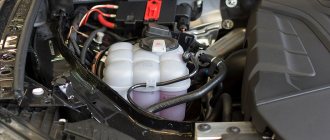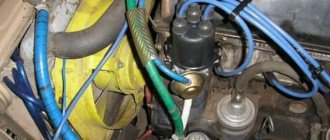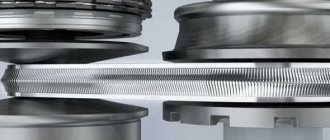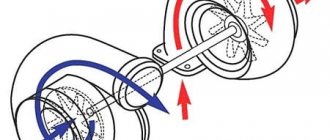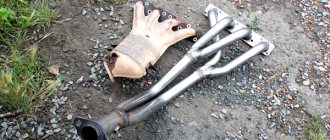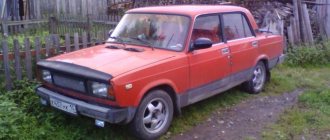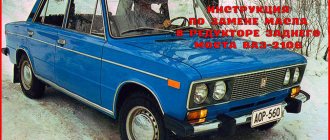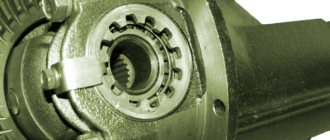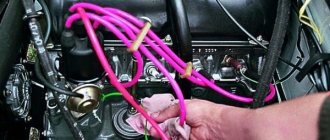Soviet cars VAZ-2103 and VAZ-2106, which are popularly called “troika” and “six”, are very similar to each other not only externally, but also in internal parts. Many inexperienced car enthusiasts often wonder: what makes these cars different? In fact, there are differences, but for the most part they are internal; the appearance differs in minimal details.
Place in the VAZ engine line
The entire classic AvtoVAZ line is a redesigned engine of the Fiat 124 model. The alteration was by no means cosmetic; already model 2101 (1970) was noticeably different from the prototype. The camshaft was moved to the upper part of the engine, the piston diameter was increased by 3 mm, and its stroke was reduced by 5.5 mm. At the same time, the engine became more responsive due to its short stroke.
Next came the 21011 engine, the cylinder diameter of which was increased by another 3 mm to a value of 79 mm. Due to this, the engine displacement has increased and the power has increased slightly. In 1972, the VAZ 2103 was released - the first four-eyed model of the Zhiguli. It was equipped with a new and most powerful engine at that time with 71 horsepower. The cylinder diameter was returned to 76 mm, and the piston stroke was increased by 14 mm. The working volume was 1452 cubic cm. This engine for a long time enjoyed the reputation of being the most durable. Even a mileage of 250 thousand km is not an incomprehensible amount for it with proper care and normal operation.
The successor to the 2103 engine (engine 2106) differs from it only in the cylinder diameter increased to 79 mm.
Reviews
This “Classic” still delights car enthusiasts. Many consider the Troika to be one of the most durable cars ever produced in the USSR. She captivated us with her high-spirited engine, attractive design and high-quality interior.
However, there are weaknesses in 2103. For example, poor corrosion resistance. This problem has plagued the car since the very beginning of production. The wheel arches, which were deprived of fender liners, were at particular risk. Also, the thresholds are rotting.
There are also complaints about the motor. The latter is prone to overheating, and its cooling system works mediocre.
More detailed information on the problems of a specific model can be found on the Internet, on the corresponding forum. There you can watch useful videos and chat with the owners.
Characteristics of the VAZ 2103 engine
The technical characteristics of the 2103 engine reflect its position in the AvtoVAZ engine line. It was installed on the VAZ 2103, 21023, 21043, 21053, 21061, 2107 models. This is an in-line four-cylinder carburetor internal combustion engine with two valves per cylinder, which runs on AI-92 gasoline. To operate the engine, oil from 5W-30 to 15W-40 is used, with a consumption of 700 g per 1000 km.
Main characteristics of the VAZ 2103 engine
| Name. | Index. |
| Length. | 565 mm. |
| Width. | 541 mm. |
| Height. | 665 mm. |
| Cylinder diameter. | 76 mm. |
| Piston stroke. | 80 mm. |
| Compression ratio. | 8,5. |
| Engine weight. | 121 kg. |
| Compression of the VAZ 2103 engine. | 1 MPa (10 bar). |
| Maximum power at a crankshaft speed of 5600 rpm. | 71 horsepower. |
| Maximum torque at 3400 rpm. | 104 Nm. |
| Fuel consumption when driving on the highway. | 6.9 l per 100 km. |
| Fuel consumption in the urban cycle. | 9.4 l per 100 km. |
| Fuel consumption in the combined cycle. | 8.9 l per 100 km. |
During the life cycle of the VAZ 2103, the engine was repeatedly refined and improved. An injection version of the engine, a version with a contactless ignition system and a host of others were created. These modifications have improved technical characteristics.
The service life of the VAZ 2103 engine, declared by the manufacturer, is 125 thousand km. In practice, the resource is often double the declared one.
Comparison table
The key features of the car brands under consideration are summarized in the table:
| Criterion | 2103 | 2106 |
| Country of assembly | USSR | USSR, Russia |
| Secondary market value | 50,000 rubles | 45,000 rubles |
| Body type | Sedan | Sedan |
| Transmission type | Four-speed manual gearbox | Five-speed manual transmission |
| type of drive | Rear | Rear |
| Engine capacity, cubic centimeters | 1452 | 1569 |
| Fuel tank volume, liters | 39 | 39 |
| Number of doors | 4 | 4 |
| Trunk volume, liters | 400 | 400 |
| Acceleration time to 100 kilometers per hour, seconds | 17 | 17 |
| Weight, kilograms | 1030 | 1035 |
| Body length, millimeters | 4116 | 4166 |
| Body height, millimeters | 1446 | 1444 |
| Wheelbase, mm | 2424 | 2424 |
| Ground clearance, millimeters | 170 | 170 |
| Fuel consumption, liters per 100 kilometers | 9,5 | 9,8 |
| Number of places | 5 | 5 |
VAZ 2103 engine design
The VAZ 2103 engine design is a classic engine with an overhead gas distribution mechanism, which has a high cylinder block. The VAZ 2103 carburetor has a distributor with a vacuum ignition timing regulator. The height of the engine is 215.9 mm instead of 207.1 (for the VAZ 2101). This made it possible to increase the working volume to 1.5 liters and use a crankshaft with an increased piston stroke.
The VAZ 2103 cylinder block is cast from special cast iron. The center-to-center distance is 95 mm, which makes it possible to increase the cylinder diameter from 76 to 79 mm. The cylinder head is made of aluminum alloy and its height is 112.5 mm.
To drive the gas distribution mechanism (GRM), a double-row bushing-roller chain with 116 links is used. There is no chain tensioner. To drive the generator and water pump, a V-belt with a cross-section of 10×8 mm and a length of 944 mm is used. The crankshaft has a crank radius of 40 mm and provides a piston stroke of 80 mm.
The pistons and valves of the VAZ 2103 model are similar to the pistons and valves of the 2101 model. The pistons are made of aluminum alloy with the outer surface coated with tin. Piston rings are made of cast iron. The barrel-shaped surface of the upper compression ring is chrome-plated. The lower compression ring is strengthened by phosphating. The oil scraper ring has an expander spring, ground at the ends and along the outer diameter.
Why is it necessary to install a 16-valve engine on a “classic”?
Classic series cars have not been produced for many years, but spare parts for them are still available for sale
Pay attention to the engine - there are only eight valves, there are just over seventy “horses” in the harness, and the timing chain makes eerie sounds, increasing the noise level. You can increase the power and acceleration of your car in several ways:
- Changing the fuel system (transition from an obsolete carburetor to an injection system).
- Replacing the engine with a more advanced model.
- In the case of fuel-injected cars, changing the ECU firmware can help (fuel consumption increases in proportion to power).
It is worth considering the second option in more detail. If you have a car with a carburetor engine, then you kill two birds with one stone - install a new engine and completely change the fuel system. It is worth mentioning that the ignition system is also being transformed - instead of a contactless one, you will need to install a microprocessor one. And hence the increase in reliability, power, and durability of the power unit.
Engine tuning 2103
The potential of the VAZ 2103 engine is so high that it is difficult to resist the temptation to squeeze more out of it. There are craftsmen who squeeze up to 200 horsepower out of a car. This kind of tuning of the VAZ 2103 engine is extreme in nature and is not recommended for everyday driving on regular roads.
There are many options for boosting an engine. One way to increase engine power and improve other performance characteristics is to convert the engine into a VAZ 2106 engine. To do this, you need to bore the cylinders to a diameter of 79 mm and replace the piston group with parts from a six. The remaining elements remain the same, the units are unified in all parts. Assembly of the VAZ 2103 engine after such tuning is carried out without problems.
Another popular way to boost this engine is to install a 0.5 bar compressor on it. This upgrade is quite simple and does not require major modifications. Such tuning can increase power up to 100 horsepower. This is a relatively affordable engine upgrade option. After all, there are ready-made installation kits on the market that provide a pressure of 0.5 or even 0.7 bar.
If you take care of your car and timely repair the VAZ 2103 engine, the car will not let you down on the road. And it will delight its owners for many years with its reliability and excellent driving performance.
The VAZ 2106 (Lada-1600), popularly called the six, is the most popular rear-wheel drive classic sedan model produced by AvtoVAZ. The car was released in 1975 and is a development of the VAZ 2103, where in addition to a modified appearance and a number of technical aspects, the power unit was modified.
In this article, we will look at both the engines themselves that were installed on the six and their characteristics. We will not ignore the shortcomings and weaknesses of these engines.
ENGINE VAZ 2106
Engine VAZ 2106 1.6 l. is a continuation of the three and, as a consequence, the power unit of the penny. The difference between the VAZ 2106 and 2103 is primarily in the piston of increased diameter, while the engine block of the 2106 is the same. There is an option with the index 21067 of the injection type, this is a banal six engine, covered with a cylinder head from the injection Niva engine 21214 from the injection Niva.
In practice, the carburetor engine of the six proved to be better than the injection one. The 2106 engine can be either injection or carburetor type, it is in-line with four cylinders, and has an overhead camshaft. Timing chain drive. The engine is a representative of the “classic” series, which is characterized by a high block.
The main and most common disadvantages of the VAZ 2106 engine include the following. The engine is demanding on oil, as well as on its timely replacement. If this requirement is ignored, the cylinder diameters increase over time. Having mentioned oil, it is necessary to note the fact that the engine is also quite gluttonous when it comes to oil. If this goes beyond reasonable limits, it is necessary to measure the compression, based on the result you can determine what the problem is: valves or rings.
The camshaft wears out quickly on the engine. In addition, it is necessary to adjust the valves in a timely manner, otherwise knocking noises may occur at idle. If we talk about extraneous noises and sounds, it should be noted that: characteristic metallic sounds indicate problems with the piston pins or connecting rod bearings, knocking while the engine warms up indicates problems with the pistons, squeaks indicate problems with the timing chain. In general, the engine is quite noisy and various noises and knocks are a frequent occurrence for it.
Read also
Age category of the site 18 +
The online publication (website) is registered by Roskomnadzor, certificate El No. FS77-80505 dated March 15, 2022. Editor-in-Chief - Sungorkin Vladimir Nikolaevich. The chief editor of the site is Olesya Vyacheslavovna Nosova.
Posts and comments from readers of the site posted without editing. The editors reserve the right to remove them from the site or edit them if these messages and comments constitute an abuse of freedom of media or a violation of other legal requirements.
127015, Moscow, Novodmitrovskaya 2B, Tel. +7 (495) 777-02-82.
Characteristic features of Soviet cars
Soviet cars have densely filled the car market, and to this day they are among the most convenient and easy to maintain. Like every car, the VAZ has its pros and cons. Each driver evaluates his financial capabilities, needs and wishes when purchasing a car and is guided solely by personal needs. If the choice nevertheless falls on the “six” or another car of this kind, then it is worth keeping in mind its characteristic features. Lada cars are not particularly resistant to corrosion, but the VAZ-2106 has higher resistance than all its “brothers”.
The interior of the Zhiguli is quite spacious and comfortable. It can comfortably seat five people, including the driver. The advantage of the Shokha is the large glove box, but the front panel is rather its disadvantage. It's not very comfortable and you can't put anything on it.
Another weak point of the Lada is its electrics. However, even at this moment, the VAZ-2106 has advantages over the “kopek” or “seven”.
Lada cars do not need frequent overhauls of the transmission and chassis, but minor problems can happen often. Since the current quality of components leaves much to be desired, the main parts that most often need replacement or repair are:
- Spherical bearing.
- Shock absorption system.
- Brake pads.
When the car's mileage reaches more than 100 km, problems with the suspension, bearings and driveshaft may occur. The gearbox also deserves special attention. If the car’s mileage is already high, then most likely it’s time to change something in the box.
The most important advantage in the Soviet automobile industry is its prevalence and accessibility. Even if the car owner, due to his inexperience, cannot cope with this or that problem, then there will definitely be comrades who can advise and help in this matter. Also, if there is a need to purchase new parts, their cost will not be too high. Finding parts for any VAZ car model will not be difficult.
Can the interior of the “six” surprise?
In 1976, no one thought about the presentability of the interior of the VAZ-2106. Thin plastic was used for the lining, so you can only dream of silence. However, for the quality of plastic, the creators can give a solid four. With good care, cracks will not form on it.
The seat upholstery is a Zhiguli feature. On cars produced before the early 80s, velor was used. It looked and felt really rich. Simple fabric upholstery appeared later.
But as for the rear, there is not enough space not only for passengers, but also for the driver. But unlike previous models, the seats have headrests.
The instrument panel is laconic: speedometer, tachometer, engine temperature, oil pressure. The center console has a dial clock, almost like a Jaguar.
Also read: The Germans about the Lada 4X4: “The car has one name…”
“Six” is a symbol of prestige and wealth of the Soviet people
To understand why all Soviet people wanted to have a “Six” from 1976 to 1982, you need to know what kind of passenger cars were in the USSR, and what each of them said about its owner. Workers and pensioners rode in ancient Moskvich vehicles, collective farmers rode in smoldering UAZs, and young engineers rode in stubby Zaporozhets. Volga drivers were a special, inaccessible caste. Officials and secret service workers drove official Volgas, while private ones were used by astronauts and rich people from the market.
The digital part of the model name is not just a set of arbitrary numeric characters. For example, the first digit 2 indicates that they belong to the “small class” of cars according to the USSR classification system
The VAZ-2106 looked the same as mid-price Mercedes models look against the backdrop of modern traffic. Naturally, a person who achieved something in life dreamed of the “Six”. By the way, in the GDR they called it the “Mercedes of the socialist camp.” And even though there was hidden irony in this expression, there was also respect for the popular Soviet car in it.
VAZ-2106
Which model should I buy?
Before the models were discontinued (“three rubles” in 1985, “sixes” in 2005), they were considered “luxury”. But the earlier car was more popular, so connoisseurs of retro cars should choose the VAZ-2103 if they:
- They love prestige and quietness;
- Speed-emphasizing design is appreciated.
2106 is preferable to buy for those who want to own a copy of the domestic classic:
- Record-breaking sales.
- With maximum displacement and developed power.
Later cars of this series have an electric window defroster and a fog lamp at the rear. Their front seats have become more comfortable, and some have changed the outside color to metallic. But it must be taken into account that over the 30-year production period the prolific “family” of this model gradually faded. This was expressed in the fact that in later modifications:
- They installed a one and a half liter and even a 1300 cc engine.
- Chrome was increasingly replaced by black plastic.
- Wood-look film has been replaced by plastic.
- The bright colors of the interior became noticeably grey.
Auto and motorcycleComment
Market price
How much does Troika cost? You can find very well-maintained examples on sale, but often you come across cars that require serious material investments and restoration of the body and interior.
The personification of high status
“Troika” stands out among the entire classic Zhiguli family
Attention is drawn to the chrome bumpers, radiator grille, as well as moldings, which add gloss and laconicism to the body design
The headlight optics are made separate. This has significantly improved the efficiency of the high beam lighting, and also gives the front end some aggression.
Unobtrusive respectability
The interior captivates with its ergonomic front panel - all controls are located in close proximity to the driver. Finishing materials are of high quality, and assembly is neat.
The front panel consists of a tachometer with a marked zone for maximum engine speed, as well as a speedometer. To the right of them are indicators for fuel level, coolant level, and engine oil pressure. Under the instruments you can find the lights and windshield wipers.
The dashboard is notable for the presence of a clock and a spacious ashtray. The climate system is controlled by two sliders. It heats the interior well in cold weather. As for the standard radio receiver, it has good signal reception and sound.
The front seats have some hint of profile and lateral support, but are still imposing and do not provide the body with proper support. Three people can sit on the back sofa, however, two people will be much more comfortable here due to the folding armrest.
With a twinkle
The half-liter engine gives the Troika a cheerful temperament - it is worth noting good traction at low speeds, as well as playful pick-up at medium speeds. The transmission and clutch work harmoniously, making it easy to get going and shift without jerking.
Moreover, the manual transmission boasts good shift clarity, but the long lever throws are somewhat disappointing.
The steering does a good job of informing the pilot about the angle of rotation of the front wheels and allows active maneuvering at speeds of up to 80 kilometers per hour. Above the specified speed, low sensitivity appears on the steering wheel, and yaw on the road is noticeable.
The suspension ensures a highly smooth ride on any uneven surfaces - even on large potholes there is no vibration or shaking. However, on long asphalt waves the rocking is intrusive.
The braking system deserves a separate discussion. A brake pedal with a long stroke makes it possible to accurately dose the braking force, but if it is depressed sharply, the wheels lock too early, which can lead to loss of control over the car.
The most important event in the domestic automobile industry was the launch in 1972 of the production of Zhiguli cars - VAZ-2103, which had much more power compared to their predecessors. Many citizens considered this car as a completely new, convenient and fast model.
For sales abroad, the VAZ-21035 and VAZ-21033 were designed with 1.3-liter units installed in them. The VAZ-21011 came with a power of 69 horsepower, or as a variation, with a more economical engine of 64 horsepower. The difference in the interior design of the VAZ-2103 from the VAZ-2101 was simply enormous. Firstly, the free space above the driver’s head was raised by 15 millimeters, secondly, the space from the ceiling of the cabin to the seat was expanded, and thirdly, the entire instrument panel was significantly transformed, in which a tachometer and a clock now appeared.
